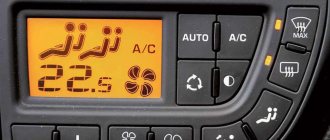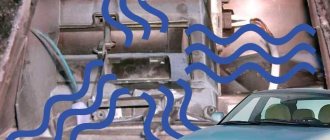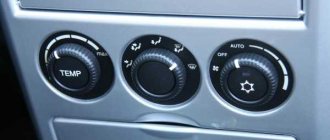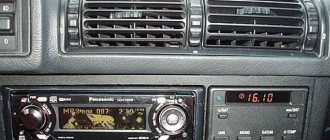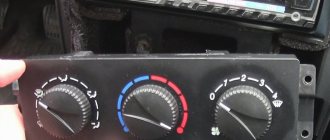Why the stove in the car does not heat well and how to deal with it
There are many reasons why the stove does not heat well. Let's start with the most common ones.
Low coolant level or air lock
auto-cool.com
Due to a leak at the connection points of the pipes or at the radiator, the coolant level in the system may decrease. This will worsen its circulation inside the heater radiator and affect its heating. Air pockets that form when replacing or adding antifreeze have the same effect.
What to do
Check the coolant level and add if necessary. If there are leaks, fix them.
To get rid of the plug, open the cap of the expansion tank and radiator (if equipped), and then squeeze several times with your hand all the thick hoses that you can reach.
Start the engine, turn the heater to maximum and let the car idle until it warms up completely. To be sure, it would be good to drive onto an overpass or some kind of hill to lift the front of the car and help the air escape. This may cause a small amount of antifreeze to splash out - be careful.
Cabin filter and air duct clogged
rightwayautorepair.com
Sometimes the cause of a poorly functioning heater can be a dirty cabin filter or leaves, insects and dust getting into the air duct due to its absence. In this case, the radiator itself warms up, but cannot release heat due to the weak air flow.
Thermostat malfunction
e46zone.com
This is a common cause of problems with the stove. If the thermostat sticks in the closed position, then the breakdown is noticed immediately, since in this case the engine overheats. But if we are talking about an open or slightly open position, then, as a rule, drivers find out about this only with the onset of cold weather.
If the thermostat is constantly open, the coolant always moves in a large circle. As a result, the engine takes a very long time to warm up, and sometimes does not warm up completely. Of course, there can be no question of any normal operation of the heater. This increases fuel consumption, and in the case of an automatic transmission, its warm-up time also slows down.
Signs of a faulty thermostat are more or less tolerable heating of the stove when driving at low speeds and cold air from the ventilation when driving on the highway. The fact that the thermostat is constantly open is indicated by the simultaneous heating of both radiator hoses. Normally, when starting the engine, one of them should be warm and the other should be cold.
Heater core blockage
macsworldwide.com
Another common reason. Typically, blockages occur due to poor-quality coolant, mixing different fluids, adding water, or using sealants for the cooling system. Deposits and scale that form inside the radiator completely clog the honeycombs and block the circulation of antifreeze.
Pump impeller wear
petroavtotrans.ru
A pump is a pump that pumps antifreeze from the engine, ensuring its continuous circulation throughout all components of the cooling system. A pump breakdown is quite difficult to miss: in this case, the engine will immediately overheat and boil.
When the impeller blades wear out due to the aggressive effects of water or low-quality antifreeze, the pump's performance drops significantly. It is still enough to ensure that the coolant somehow circulates and the engine does not overheat, but it is no longer enough to fully warm up the heater radiator.
Fan problems
Coldness in the cabin can be caused not only by insufficient heating of the heater radiator, but also by weak ventilation. The fan is to blame for this because it does not provide the necessary air flow and heat removal from the radiator.
Damper servo drive failure
drive2.ru
Another reason why the stove heats up, but the heat does not reach the interior, is a malfunction of the damper. In all modern cars, the heater radiator heats up constantly, and heat comes from it only when the air duct damper is open. If the damper does not open or does not open completely, there can be no talk of an optimal temperature.
The damper is driven by a servomotor, which is controlled by a knob or buttons on the climate control panel. The problem can be either a breakdown of the servo drive itself or slipping of the cables or rods that drive the damper.
Damage to the heater control unit
jpauleytoyota.com
In addition, the air damper may not open due to malfunctions in the climate control unit or temperature sensors. In this case, the required signal is simply not sent to the drive, which in turn does not open the damper, and instead of hot air, cold air enters the cabin.
Heater housing leakage and radiator displacement
subaruoutback.org
A fairly rare problem is a violation of the seal of the housing. After an accident or improper assembly, the plastic parts of the stove may be damaged or have gaps through which hot air will escape. In this case, the efficiency of the heater will decrease significantly.
In some cars, due to weak latches or other design flaws, the radiator may move out of its place, and the air pumped by the fan will not pass through it, but past it. The same thing happens when the air duct damper is closed, that is, there is no heat to speak of.
Cylinder head gasket failure
The most unpleasant problem, which, fortunately, is quite rare. Due to overheating of the engine and poor tightening of the cylinder head, at some point the gasket under it may become damaged. If a breakdown occurs between the cooling jacket and the combustion chamber, then gases from it will enter the antifreeze, forming bubbles and impairing circulation, and in some cases even creating air locks.
You can recognize a gasket breakdown by thick white smoke, or more precisely, steam from the muffler, which is formed when coolant enters the cylinder. At the same time, the air will bubble in the expansion tank, and due to the increased pressure, the antifreeze may boil out and even splash out.
The stove blows cold air: possible causes of the malfunction
- How the stove works
- Why does the stove blow cold air?
- How to fix a stove that is blowing cold air
- How to wash the stove in a car
In most regions of Russia, it is impossible to do without a car interior heating system. However, sometimes you may encounter a situation where, with the onset of cold weather, the need for heating arises, but when you turn on the stove, you feel that cold air is coming from the air ducts. In this article we will look at why the stove blows cold air and what to do in such circumstances.
How does a car heater work?
The warm air entering the car interior is generated by the engine and coolant. By washing the hot parts of the engine, antifreeze cools them. The heat generated in this way is released into the atmosphere in the summer; in the cold season, the liquid entering the radiator through the pipes is partially used to heat the interior.
Operating principle of a car heater
In the history of the car, there were even such types of interior heating as compact coal and wood stoves, and gas lamps. Later, exhaust gases were used for heating. Automakers have practically abandoned water-based interior heating, which was used in some models of passenger buses. Heated water circulating through pipelines under the seats and on the walls of the cabin quickly cooled, and the heating system had low efficiency.
Modern heating systems primarily use engine coolant to heat the interior using heated and filtered atmospheric air. A fan is used for forced air intake. The air is heated by the heat transfer of a running automobile engine, the intensity of its supply is regulated manually or automatically.
A normally functioning car heater, which drivers simply call a “stove,” heats the air in the cabin to 20–25 degrees Celsius in winter. An additional function of a car heater is to warm up foggy or frozen car windows and defrost frozen windshield wipers.
The heater in the car does not heat well - reasons
All the reasons why the stove in the car does not heat are divided into two main groups: malfunctions of the heating system and problems with the cooling system. To understand the situation, we’ll tell you about the main causes of failures: old antifreeze is to blame or the thermostat is not working.
The stove in a car is designed quite simply: coolant (antifreeze or antifreeze) taken from the running engine flows into the radiator, installed under the dashboard, through pipes. The fluid control system includes an air duct, an air damper with drives, and a thermostat that regulates the supply of cooling solution. The fan blows on the radiator and supplies a heated stream of air inside the car, blowing the interior of the car.
Thus, the failure of one of the components of the system will affect the functioning of the entire mechanism. For example, the thermostat will jam and the engine will not be able to reach operating temperature (85-90 degrees), so the car will be cold when the heater is running at full power.
Is it that simple?
Given the apparent simplicity of the heating principle, an air-powered auxiliary heater can hardly be considered as an additional interior heater that can be manufactured with your own hands. In conditions of home-made production, it is practically very difficult to fulfill the requirements:
- to the quality of welding of elements, taking into account the specifics of the thermal load and deformation of the mating elements;
- to the reliability of control systems necessary for the operation of an autonomous heater;
- to prevent deviations from the specified combustion mode, the formation of a large amount of carbon monoxide, burning of the chamber walls and, as a consequence, mixing of combustion products and heated air;
- to ensure control of the launch procedure without the risk of fire.
Why doesn't the heater in my car heat up?
The need for a stove appears with the arrival of the first cold weather. Every motorist in winter wants to take refuge in a warm and comfortable car interior that will protect from bad weather. But it happens that the stove works poorly, heats poorly or does not heat at all. The problem is most acute when the car that needs to be warmed up has been left idle for a long time. The cause of problems can be a breakdown of any component of the heating system.
The correct operation of the stove is determined by the serviceability of each of its parts. It includes a radiator, a valve that regulates the movement of liquid, pipes, an air duct, dampers and a fan.
The main reasons why the stove in the car does not heat
The heater works by removing heat from the engine into the vehicle interior. Basically, breakdowns are divided into two types: a malfunction in the heating system itself and a malfunction in the cooling system.
Before talking about possible damage, you need to figure out why the stove doesn’t heat up or doesn’t immediately start supplying heat to the car, but blows cold air. In severe frosts, when the temperature is below -15, it will not be possible to immediately warm up the car and you will have to warm it up to 20 minutes to start supplying heat to the interior.
If the heater in your car is blowing cold air, check the interior heating system
The radiator is the main component of the stove, which is designed to preheat the incoming air. This is where you need to start checking:
- Clogged channels. The liquid simply cannot pass through the radiator. The reason may be the addition of various additives and liquids to antifreeze, which entails the formation of solid components. You can solve the problem by buying a new part or washing it.
- Faulty electric motor that rotates the fan. This happens when the radiator heats up, but warm air never enters the cabin. You can correct the situation by purchasing a new electric motor.
- Damage to the control buttons is another reason why the stove does not work. Having identified a breakdown, you simply need to replace the damaged element.
- Clogged filter. A dirty filter is also one of the possible causes of problems. Simply replace the consumable with a new one.
